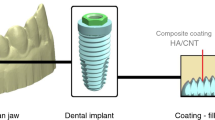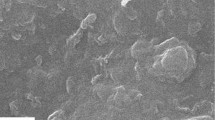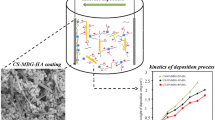Abstract
Microfluidics points to the manner of fluids at micro- and nano-scales levels. This research aims to find the heat transfer rate of hydroxyapatite bio-ceramic and its composite (HA/carbon nanotube) to find the optimized volume fraction for the human blood plasma through the vessel micro-flow. It can also be used in the teeth reach extreme temperatures, causing the tooth thermal pain. To find the answer, the body condition through time was considered. Thus, simulated body fluid, which acts as an adhesive to bond artificial materials to living bones, was chosen as the solution close to mouth-environment. Hydroxyapatite is a ceramic-based material which has bioactivity and biocompatibility. However, carbon nanotube, which is a carbon-based material, has high tensile strength and stiffness, that could likely be utilized to reinforce hydroxyapatite. The results showed that heat transfer rate for hydroxyapatite bio-ceramic dispersed in simulated body fluid solution in 1, 14 and 28 days, decreased − 14.8785%, − 15.4279% and − 17.4450%, respectively; thus, time effect was 2.5965%. Also, heat transfer rate for HA/carbon nanotube dispersed in simulated body fluid solution in 1, 14 and 28 days enhanced 25.1189%, 25.6410% and 25.7923%, respectively; thus, time effect was 0.6734%. This study proved that time can affect the heat transfer rate in simulated body fluid solution.









Similar content being viewed by others
Data Availability Statement
This manuscript has associated data in a data repository. [Authors’ comment: All data included in this manuscript are available upon request by contacting with the corresponding author.]
References
R.B. Ganvir, P.V. Walke, V.M. Kriplani, Heat transfer characteristics in nanofluid—a review. Renew. Sustain. Energy Rev. 75, 451–460 (2017). https://doi.org/10.1016/j.rser.2016.11.010
R. Lenin, P.A. Joy, C. Bera, A review of the recent progress on thermal conductivity of nanofluid. J. Mol. Liq. (2021). https://doi.org/10.1016/j.molliq.2021.116929
S. Chakraborty, P.K. Panigrahi, Stability of nanofluid: a review. Appl. Therm. Eng. 174, 115259 (2020). https://doi.org/10.1016/j.applthermaleng.2020.115259
M. Ibrahim, T. Saeed, Y.M. Chu, H.M. Ali, G. Cheraghian, R. Kalbasi, Comprehensive study concerned graphene nano-sheets dispersed in ethylene glycol: experimental study and theoretical prediction of thermal conductivity. Powder Technol. 386, 51–59 (2021). https://doi.org/10.1016/j.powtec.2021.03.028
A. Moradikazerouni, K. Shoele, Computational study of Rayleigh-Bernard convection in a cylindrical pressurized cryogenic tank. Bull. Am. Phys. Soc. (2021)
S. Rostami, S. Aghakhani, A. Hajatzadeh Pordanjani, M. Afrand, G. Cheraghian, H.F. Oztop, M.S. Shadloo, A review on the control parameters of natural convection in different shaped cavities with and without nanofluid. Processes 8(9), 1011 (2020). https://doi.org/10.3390/pr8091011
C. Estebe, Y. Liu, M. Vahab, M. Sussman, A. Moradikazerouni, K. Shoele, W. Guo, A low mach number, adaptive mesh method for simulating multi-phase flows in cryogenic fuel tanks
A.H. Pordanjani, S. Aghakhani, M. Afrand, M. Sharifpur, J.P. Meyer, H. Xu, H.M. Ali, N. Karimi, G. Cheraghian, Nanofluids: physical phenomena, applications in thermal systems and the environment effects-a critical review. J. Clean. Prod. (2021). https://doi.org/10.1016/j.jclepro.2021.128573
A. Moradikazerouni, M. Vahab, K. Shoele, A 0D/3D nodal-CFD method of cylindrical pressurized tanks. In APS Division of Fluid Dynamics Meeting Abstracts, pp. T01–014 (2020)
G. Cheraghian, Improved heavy oil recovery by nanofluid surfactant flooding-an experimental study. In 78th EAGE conference and exhibition 2016, vol. 2016, no. 1, pp. 1–5. European Association of Geoscientists & Engineers (2016). https://doi.org/10.3997/2214-4609.201601509
Y. Giannareas, K. Shoele, Surveillant and hydrodynamic benefits of fish schooling. Bulletin of the American Physical Society (2021)
K.H. Almitani, N.H. Abu-Hamdeh, S. Etedali, A. Abdollahi, A.S. Goldanlou, A. Golmohammadzadeh, Effects of surfactant on thermal conductivity of aqueous silica nanofluids. J. Mol. Liq. 327, 114883 (2021). https://doi.org/10.1016/j.molliq.2020.114883
T. Kokubo, S. Yamaguchi, Simulated body fluid and the novel bioactive materials derived from it. J. Biomed. Mater. Res., Part A 107(5), 968–977 (2019). https://doi.org/10.1002/jbm.a.36620
D.S. Gomes, A.M. Santos, G.A. Neves, R.R. Menezes, A brief review on hydroxyapatite production and use in biomedicine. Cerâmica 65(374), 282–302 (2019). https://doi.org/10.1590/0366-69132019653742706
J. Ren, D. Zhao, F. Qi, W. Liu, Y. Chen, Heat and hydrothermal treatments on the microstructure evolution and mechanical properties of plasma sprayed hydroxyapatite coatings reinforced with graphene nanoplatelets. J. Mech. Behav. Biomed. Mater. 101, 103418 (2020). https://doi.org/10.1016/j.jmbbm.2019.103418
M.J. Assael, C.F. Chen, I. Metaxa, W.A. Wakeham, Thermal conductivity of suspensions of carbon nanotubes in water. Int. J. Thermophys. 25(4), 971–985 (2004). https://doi.org/10.1023/B:IJOT.0000038494.22494.04
M. Moghaddari, F. Yousefi, S. Aparicio, S.M. Hosseini, Thermal conductivity and structuring of multiwalled carbon nanotubes based nanofluids. J. Mol. Liq. 307, 112977 (2020). https://doi.org/10.1016/j.molliq.2020.112977
Z. Yang, J. Tian, Z. Yin, C. Cui, W. Qian, F. Wei, Carbon nanotube-and graphene-based nanomaterials and applications in high-voltage supercapacitor: a review. Carbon 141, 467–480 (2019). https://doi.org/10.1016/j.carbon.2018.10.010
T. Hayat, Z. Hussain, B. Ahmed, A. Alsaedi, Base fluids with CNTs as nanoparticles through non-Darcy porous medium in convectively heated flow: a comparative study. Adv. Powder Technol. 28(8), 1855–1865 (2017). https://doi.org/10.1016/j.apt.2017.04.003
A. Abidi, Z. Jokar, S.M.R. Allahyari, F. Kolahi Sadigh, S.M. Sajadi, P. Firouzi, D. Baleanu, F. Ghaemi, A. Karimipour, Improve thermal performance of simulated-body-fluid as a solution with an ion concentration close to human blood plasma, by additive zinc oxide and its composites: ZnO/carbon nanotube and ZnO/hydroxyapatite. J. Mol. Liq. (2021). https://doi.org/10.1016/j.molliq.2021.117457
C. Du, Q. Nguyen, O. Malekahmadi, A. Mardani, Z. Jokar, E. Babadi, A. D’Orazio, A. Karimipour, Z. Li, Q.V. Bach, Thermal conductivity enhancement of nanofluid by adding multiwalled carbon nanotubes: Characterization and numerical modeling patterns. Math. Methods Appl. Sci. (2020). https://doi.org/10.1002/mma.6466
A. Karimipour, O. Malekahmadi, A. Karimipour, M. Shahgholi, Z. Li, Thermal conductivity enhancement via synthesis produces a new hybrid mixture composed of copper oxide and multi-walled carbon nanotube dispersed in water: experimental characterization and artificial neural network modeling. Int. J. Thermophys. 41(8), 116 (2020). https://doi.org/10.1007/s10765-020-02702-y
J. Alsarraf, O. Malekahmadi, A. Karimipour, I. Tlili, A. Karimipour, M. Ghashang, Increase thermal conductivity of aqueous mixture by additives graphene nanoparticles in water via an experimental/numerical study: Synthesise, characterization, conductivity measurement, and neural network modeling. Int. Commun. Heat Mass Transfer 118, 104864 (2020). https://doi.org/10.1016/j.icheatmasstransfer.2020.104864
Q. Nguyen, P. Ghorbani, S.A. Bagherzadeh, O. Malekahmadi, A. Karimipour, "Performance of joined artificial neural network and genetic algorithm to study the effect of temperature and mass fraction of nanoparticles dispersed in ethanol. Math. Methods Appl. Sci. (2020). https://doi.org/10.1002/mma.6688
Z. Ying, B. He, Di. He, Y. Kuang, J. Ren, Bo. Song, Comparisons of single-phase and two-phase models for numerical predictions of Al2O3/water nanofluids convective heat transfer. Adv. Powder Technol. 31(7), 3050–3061 (2020). https://doi.org/10.1016/j.apt.2020.05.032
I.O. Alade, T.A. Oyehan, I.K. Popoola, S.O. Olatunji, A. Bagudu, Modeling thermal conductivity enhancement of metal and metallic oxide nanofluids using support vector regression. Adv. Powder Technol. 29(1), 157–167 (2018). https://doi.org/10.1016/j.apt.2017.10.023
E.M. Achhal, H. Jabraoui, S. Zeroual, H. Loulijat, A. Hasnaoui, S. Ouaskit, Modeling and simulations of nanofluids using classical molecular dynamics: particle size and temperature effects on thermal conductivity. Adv. Powder Technol. 29(10), 2434–2439 (2018). https://doi.org/10.1016/j.apt.2018.06.023
Q. Nguyen, R. Rizvandi, A. Karimipour, O. Malekahmadi, Q.V. Bach, A novel correlation to calculate thermal conductivity of aqueous hybrid graphene oxide/silicon dioxide nanofluid: synthesis, characterizations, preparation, and artificial neural network modeling. Arab. J. Sci. Eng. 45(11), 9747–9758 (2020). https://doi.org/10.1007/s13369-020-04885-w
C. Sun, S. Taherifar, O. Malekahmadi, A. Karimipour, A. Karimipour, Q.V. Bach, Liquid paraffin thermal conductivity with additives tungsten trioxide nanoparticles: synthesis and propose a new composed approach of fuzzy logic/artificial neural network. Arab. J. Sci. Eng. 46, 2543–2552 (2021). https://doi.org/10.1007/s13369-020-05151-9
H. Saniei, S. Mousavi, Surface modification of PLA 3D-printed implants by electrospinning with enhanced bioactivity and cell affinity. Polymer 196, 122467 (2020)
R. Bakhtiari, B. Kamkari, M. Afrand, A. Abdollahi, Preparation of stable TiO2-graphene/water hybrid nanofluids and development of a new correlation for thermal conductivity. Powder Technol. 385, 466–477 (2021)
Acknowledgements
“The authors extend their appreciation to the Deputyship for Research and Innovation, Ministry of Education in Saudi Arabia for funding this research work through the project number IFPIP-429-135-1442 and King Abdulaziz University, DSR, Jeddah, Saudi Arabia.”
Author information
Authors and Affiliations
Corresponding author
Rights and permissions
About this article
Cite this article
Abu-Hamdeh, N.H., Daqrouq, K.O., Karimipour, A. et al. Thermal management of carbon-based dental laminate via additives carbon nanotube and hydroxyapatite in a vessel micro-flow based on the numerical/empirical data. Eur. Phys. J. Plus 137, 137 (2022). https://doi.org/10.1140/epjp/s13360-022-02366-7
Received:
Accepted:
Published:
DOI: https://doi.org/10.1140/epjp/s13360-022-02366-7




